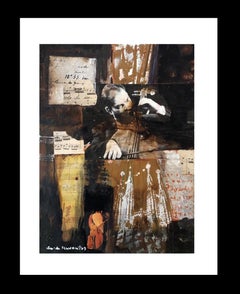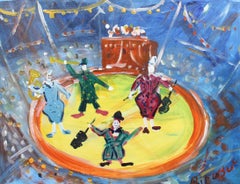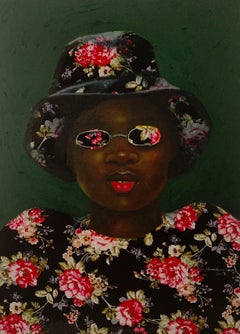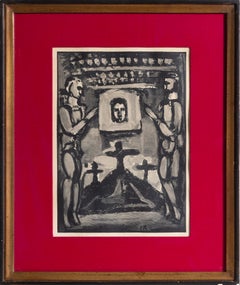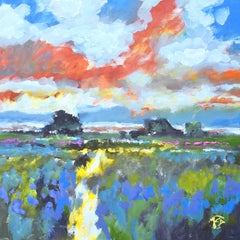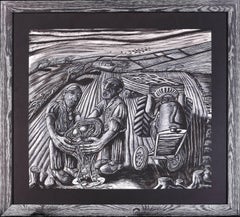Expressionist Art
While “expressionist” is used to describe any art that avoids naturalism and instead employs a bold use of flattened forms and intense brushwork, Expressionist art formally describes early-20th-century work from Europe that drew on Symbolism and confronted issues such as urbanization and capitalism. Expressionist artists experimented in paintings and prints with skewed perspectives, abstraction and unconventional, bright colors to portray how isolating and anxious the world felt rather than how it appeared.
Between 1905 and 1920, Austrian and German artists, in particular, were inspired by Postimpressionists such as Paul Gauguin and Vincent van Gogh in their efforts to strive for a new authenticity in their work. In its geometric patterns and decorative details, Expressionist art was also marked by eclectic sources like German and Russian folk art as well as tribal art from Africa and Oceania, which the movement’s practitioners witnessed at museums and world’s fairs.
Groups of artists came together to share and promote the themes now associated with Expressionism, such as Die Brücke (The Bridge) in Dresden, which included Erich Heckel, Ernst Ludwig Kirchner and Karl Schmidt-Rottluff and investigated alienation and the dissolution of society in vivid color. In Munich, Der Blaue Reiter (The Blue Rider), a group led by Wassily Kandinsky and Franz Marc, instilled Expressionism with a search for spiritual truths. In his iconic painting The Scream, prolific Norwegian painter Edvard Munch conveyed emotional turmoil through his depiction of environmental elements, such as the threatening sky.
Expressionism shifted around the outbreak of World War I, with artists using more elements of the grotesque in reaction to the escalation of unrest and violence. Printmaking was especially popular, as it allowed artists to widely disseminate works that grappled with social and political issues amid this time of upheaval. Although the art movement ended with the rise of Nazi Germany, where Expressionist creators were labeled “degenerate,” the radical ideas of these artists would influence Neo-Expressionism that emerged in the late 1970s with painters like Jean-Michel Basquiat and Francesco Clemente.
Find a collection of authentic Expressionist paintings, sculptures, prints and more art on 1stDibs.
2010s Expressionist Art
Acrylic, Cardboard
1970s Expressionist Art
Paper, Gouache
21st Century and Contemporary Expressionist Art
Fabric, Canvas, Oil, Mixed Media
1930s Expressionist Art
Woodcut
Artist Comments
Bold brushstrokes capture the lively yet restful energy of a marsh. The colors shift and blend, reflecting the ever-changing landscape. The scene portrays the...
21st Century and Contemporary Expressionist Art
Acrylic
Late 20th Century Expressionist Art
Paper, Pastel
1960s Expressionist Art
Oil, Board
21st Century and Contemporary Expressionist Art
Canvas, Wood, Acrylic
Mid-20th Century Expressionist Art
Lithograph
2010s Expressionist Art
Canvas, Oil, Cardboard, Giclée
Early 2000s Expressionist Art
Acrylic
21st Century and Contemporary Expressionist Art
Oil
2010s Expressionist Art
Canvas, Oil, Cardboard, Giclée
1990s Expressionist Art
Watercolor
1960s Expressionist Art
Paper, Etching
21st Century and Contemporary Expressionist Art
Ballpoint Pen, Paper
2010s Expressionist Art
Canvas, Oil
21st Century and Contemporary Expressionist Art
Canvas, Mixed Media
Early 2000s Expressionist Art
Acrylic
1990s Expressionist Art
Wood, Oil
1930s Expressionist Art
Ink, Mixed Media
21st Century and Contemporary Expressionist Art
Canvas, Charcoal, Acrylic
1940s Expressionist Art
Canvas, Oil
2010s Expressionist Art
Canvas, Oil
21st Century and Contemporary Expressionist Art
Canvas, Oil
1970s Expressionist Art
Canvas, Oil
2010s Expressionist Art
Canvas, Oil, Cardboard
21st Century and Contemporary Expressionist Art
Canvas, Oil
1960s Expressionist Art
Canvas, Oil
2010s Expressionist Art
Canvas, Oil
2010s Expressionist Art
Bronze
1990s Expressionist Art
Watercolor, Handmade Paper
21st Century and Contemporary Expressionist Art
Fabric, Canvas, Oil
2010s Expressionist Art
Canvas, Oil
2010s Expressionist Art
Canvas, Oil
Early 20th Century Expressionist Art
Oil
Early 2000s Expressionist Art
Etching
Late 20th Century Expressionist Art
Crayon, Paper
21st Century and Contemporary Expressionist Art
Canvas, Wood, Acrylic
21st Century and Contemporary Expressionist Art
Oil, Board
2010s Expressionist Art
Canvas, Oil
1960s Expressionist Art
Lithograph
2010s Expressionist Art
Canvas, Oil
2010s Expressionist Art
Canvas, Oil
Early 1900s Expressionist Art
Tempera, Cardboard
1960s Expressionist Art
Lithograph
1930s Expressionist Art
Oil
2010s Expressionist Art
Oil
21st Century and Contemporary Expressionist Art
Fabric, Canvas, Mixed Media, Oil
Late 20th Century Expressionist Art
Canvas, Acrylic, Stretcher Bars
21st Century and Contemporary Expressionist Art
Canvas, Acrylic
Early 20th Century Expressionist Art
Woodcut
1940s Expressionist Art
Etching
1920s Expressionist Art
Drypoint, Etching, Aquatint
1960s Expressionist Art
Oil, Masonite
2010s Expressionist Art
Canvas, Linen, Oil
2010s Expressionist Art
Canvas, Oil
Artist Comments
Artist James Hartman began this painting by creating texture with homemade tools. He envisioned standing at the edge of the woods, looking through to an indistinct light. The oil colors were allowed to drip and settle into the textured surface, enhancing depth and movement, while his tools helped define the landscape in a way that captures shifting light.
About the Artist
When James Hartman was in art school, he became fascinated with the Society of Six, a group of artists who painted en plein air (outdoors) and exhibited together in the San Francisco Bay Area during the early 20th Century. James's paintings of the Northern California landscape pay tribute to some of the great Bay Area artists of the past. His expressive scenes feel alive through his vibrant use of color and his painterly brushwork. James’s paintings have an immediate visual impact from a distance, yet up close, dissolve into a series of confident marks and strokes. There is a simultaneous complexity and steadiness in his flattened, color-blocked planes. Knowledge and observation are essential elements of James’s working practice. To this end, he spends a large proportion of his time painting on location. His body of work captures the fresh and sunlit essence of the coastal California hills.
Words that describe this painting: trees, texture, bright, woods, sunlight, panoramic, forest...
21st Century and Contemporary Expressionist Art
Oil
1970s Expressionist Art
Watercolor
1960s Expressionist Art
Acrylic, Canvas
